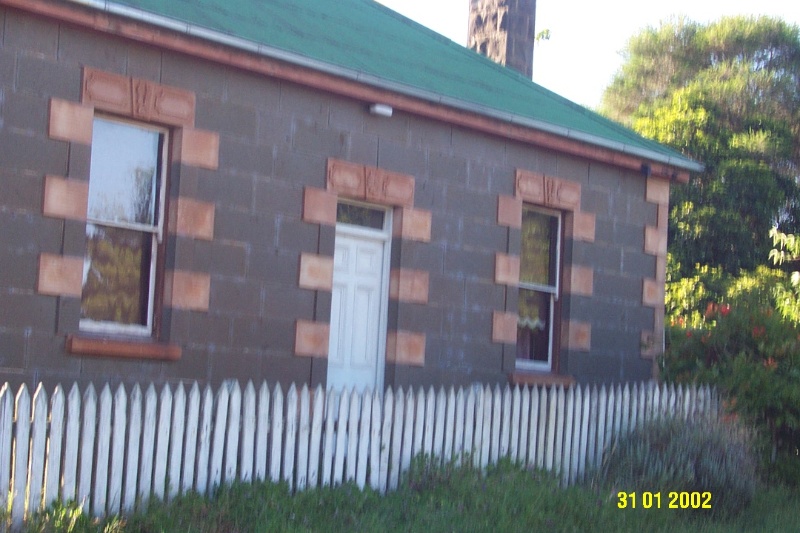WILLIAM HOWARTH'S HOUSE
Monroe Street, BRANXHOLME VIC 3302 - Property No 3350
-
Add to tour
You must log in to do that.
-
Share
-
Shortlist place
You must log in to do that.
- Download report


Statement of Significance
William Howarth's house is located at the southern end of Monroe Street, Branxholme. William Howarth J.P. was born in Lancashire, England, arrived in Sydney, then came to Branxholme in the late 1850s where he was a storekeeper. He was the magistrate in Branxholme between 1874 and 1903. He was also one of the trustees of the Mutual Improvement Association which built the local Mechanics Institute in 1883. Howarth purchased the land in 1858 and built a simple vernacular building towards the rear and on one side. This survives, little altered and in fair condition although with some structural failure. In 1861, he opened a shop called the 'New Store' and acted as a banker as well as supplying a variety of goods. He must have prospered because he had the stone house built in front of his first residence in 1865. The quality of the detailing and workmanship, suggest that the house was designed by the leading Hamilton architect, Charles Henry Fox. The facade is particularly distinguished for its combination of bluestone ashlar and Grampians freestone quoins and lintels. The latter are very finely dressed and carved with unusual iconography. The second house retains an excellent degree of integrity and is in good condition. The juxtaposition of two dwellings in an urban context is rare. The short sheeted corrugated iron surviving on the main roof is also rare.
How is it significant?
The William Howarth House, Branxholme is of historical, social and architectural significance for the Southern Grampians Shire and the State of Victoria.
Why is it significant?
The William Howarth House, is of historical significance for its link with the successful British immigrant William Howarth, who came to Australia during to Gold Rush period and became a modestly successful storekeeper. It is of social significance as a reflection of his life as an important citizen in a small township. The complex of two dwellings is of architectural significance for its juxtaposition of the two dwellings, the distinguished design and excellent construction of the second dwelling and for its probable connection with the important architect, Charles Henry Fox.
-
-
WILLIAM HOWARTH'S HOUSE - Physical Conditions
The original cottage is in poor condition externally and internally. The front wing is in excellent condition throughout.
WILLIAM HOWARTH'S HOUSE - Physical Description 1
The rear section of the residence, built of stone in or soon after 1858, is set back a distance from the front street boundary. It takes the form of an early colonial bungalow with a verandah on four sides, partly enclosed across the south and rear elevations. The rear skillion has been raised slightly with higher walls. The main and verandah roofs are contiguous, low pitched and covered in corrugated iron.
The front section of the residence, built in 1865, is a simple but particularly distinguished example of late Georgian architecture which would be as likely in pre-1840 New South Wales or Tasmania. It is single storeyed, symmetrical and has a simple hipped roof. The roof is still clad with the original very short sheets of galvanised iron. The walls are very finely dressed bluestone with remarkable quoining at the corners and around the door and windows. The quoins are in a distinctive orange sandstone, probably from the Grampians, in marked contrast to the muted grey of the bluestone. A powerboard, introduced on the right side of the front door, is the only compromise to the original condition of the facade.
The interior is simple and conventional with a central passage, two rooms on the north side and, unusually, one large room on the south side. The interiors appear not to have changed since before the Second World War with decoration, paint and paper finishes, and joinery details intact.WILLIAM HOWARTH'S HOUSE - Historical Australian Themes
Theme 3: Developing local, regional and national economies
3.19 Marketing and retailing
Theme 7: Governing
7.6 Administering Australia
7.6.4 Dispensing justice
Theme 8: Developing Australia's cultural life
8.12 Living in and around Australian homes
8.14 Living in the country and rural settlementsWILLIAM HOWARTH'S HOUSE - Usage/Former Usage
private residence.
WILLIAM HOWARTH'S HOUSE - Integrity
Excellent degree of integrity for the exteriors of both sections. The interiors of the original cottage are in poor condition.
WILLIAM HOWARTH'S HOUSE - Physical Description 2
William Howarth, JP Magistrate and storekeeper, first owner
Heritage Study and Grading
Southern Grampians - Southern Grampians Shire Heritage Study
Author: Timothy Hubbard P/L, Annabel Neylon
Year: 2002
Grading:
-
-
-
-
-
BASSETT HOMESTEAD COMPLEX
 Southern Grampians Shire
Southern Grampians Shire -
POST OFFICE (FORMER)
 Southern Grampians Shire
Southern Grampians Shire -
KOOKABURRA CAFÉ
 Southern Grampians Shire
Southern Grampians Shire
-
'Altona' Homestead (Formerly 'Laverton' Homestead) and Logan Reserve
 Hobsons Bay City
Hobsons Bay City
-
-












